High-Performance Glazing Systems
Making the Choice Between Storefront, Curtain Wall and Pre-Glazed Windows
![]() Continuing Education
Continuing Education
Use the following learning objectives to focus your study while reading this month’s Continuing Education article.
Learning Objectives - After reading this article, you will be able to:
- Identify and recognize the attributes and features of high-performance windows as defined by national standards including energy and thermal performance.
- Assess the strengths and limitations of common storefront window systems in meeting high-performance criteria.
- Investigate and compare the differences between storefront systems and curtain wall window systems related to performance criteria.
- Explore the types of applications where pre-glazed windows may be the preferred choice for optimum performance in non-residential buildings.
Virtually every building has window systems of some type, and architects spend a fair amount of time during the design process discerning the best choices for a particular project. Selecting and specifying windows and glazing certainly has a significant impact on the overall design and aesthetic of a building but equally important is the overall quality of the window system in terms of durability, weather resistance and physical integrity.
Further, in this energy-conscious era, the thermal performance of windows has become a major design consideration as well. Assessing all of these variables, particularly in commercial, industrial and institutional buildings usually comes down to three fundamental choices: storefront glazing systems, curtain wall systems or pre-glazed manufactured windows. Of course, there are also further variations to consider within each related to appearance, cost, customization, fabrication and installation.
Understanding the differences between these three choices and their respective strengths and weaknesses will allow architects to choose the most desirable and best performing system for an individual building design.
Characteristics of High-Performance Windows
By definition, high-performance windows need to perform better than conventional window systems. This applies in several ways. First their inherent internal structure must be adequate and appropriate to the installation and the wind, water, and other loading stresses it will encounter. Building codes usually dictate minimum performance requirements in this regard, but there can be many instances where a higher level of structural performance is required to provide greater protection against natural forces such as hurricanes or earthquakes or against man-made forces such as blast resistance.
 |
In this low-rise building, the field-assembled curtain wall system provides superior performance compared to other choices. Photo courtesy of Manko Window Systems, Inc. |
Second, high-performance windows need to exhibit superior thermal control related to heat transfer, solar transfer and air infiltration. Energy codes and ASHRAE 90.1 are quite commonly known for helping to establish minimum energy performance but buildings that are pursuing certification or demonstration of superior energy performance will need windows that perform beyond the minimum. The National Institute of Building Sciences (NIBS) produces the Whole Building Design Guide (WBDG). Within it they suggest a number of strategies to improve energy performance in buildings, including installation of high-performance windows. They define this strategy further by several specific tactics:
- Specify frame and sash materials fabricated with low thermal conductivity
- Specify windows with a whole-unit U-factor less than 0.49 (greater than R-2.1). Go to the next level with super-windows that have a whole-unit U-factor less than 0.25 (greater than R-4.0)
- Avoid divided-lite windows to reduce edge losses
In selecting and specifying high-performance window systems, it is appropriate to use recognized national standards to establish benchmarks and targets for achieving the desired results. There are two very important organizations that provide a great deal of insight and direction in this regard:
 |
The National Institute of Building Science (NIBS) identifies ways to make windows in buildings truly high performing. Photo courtesy of Manko Window Systems, Inc. |
The American Architectural Manufacturers Association (AAMA)
By their own definition, "AAMA is the source of performance standards, product certification and educational programs for the fenestration industry. AAMA's membership is comprised of window, door, skylight, curtain wall and storefront manufacturers, suppliers and test labs." Among the standards developed by AAMA, the performance-based and material-neutral North American Fenestration Standard or NAFS (AAMA/WDMA/CSA 101/I.S.2/A440), is referenced in current International Building Codes as the basis for third-party testing and certification of windows, doors and skylights. This standard identifies four Performance Classes which each contain their own set of performance requirements related to use and location within a building. Within each class, a specific Performance Grade is identified corresponding to a design pressure range expressed in pounds per square foot (psf) or pascals (Pa) of pressure exerted during testing. This testing simulates the effect of wind and rain pressure on a window system when it is installed in a building. To qualify for a given performance grade (PG), a representative specimen of a manufactured product must pass all required performance tests for the following:
a) Operating force (if applicable)
b) Air leakage resistance
c) Water penetration resistance
d) Uniform load deflection test
e) Uniform load structural test
f) Forced-entry resistance (if applicable)
Note that each Performance Class is identified by "entry level" or "gateway" minimum Performance Grade levels to simplify the task of matching window system performance to project requirements. These AAMA Performance designations are as follows:
- R class (Residential)—commonly used in one- and two-family dwellings and designed to withstand pressures of at least 15 psf (720 Pa)
- LC class (Light Commercial)—commonly used for low- and mid-rise multifamily dwellings or other buildings where larger sizes and higher loading requirements are expected and designed to withstand pressures of at least 25 psf (1200 Pa)
- CW class (Commercial)—commonly used in low- and mid-rise buildings where larger sizes, higher loading requirements, limits on deflection and heavier use are expected and designed to withstand pressures of at least 30 psf (1,440 Pa)
- AW class (Architectural)—commonly used in high-rise and mid-rise buildings to meet increased loading requirements and limits on deflection and in buildings where frequent and extreme use of the fenestration products is expected and designed to withstand pressures of at least 40 psf (1,920 Pa). This class of window system in particular is most able to achieve the status of "high-performance" windows due to the higher capabilities.
When selecting a particular Performance Class, there is also the option to specify the pressure requirements above the minimum gateway requirements listed above (in increments of 5 psf) up to 100 psf maximum except in category AW which has no stated maximum (practical limits exist). So, for example, a light commercial system could be specified at the minimum Performance Grade level with the designation class LC-PG25 or an optional increased level of performance as class LC-PG35 indicating that passing a pressure test of 35 psf is required. The designation may also additionally include the size tested and any specific product type related to operable or fixed-in-place windows.
Beyond structural performance, there is another significant factor associated with these tests for performance, namely water management. All window systems are designed to resist water penetration, and the higher the Performance Grade, the more wind-driven rain they should be able to resist. But no system is perfect and some water seepage is certainly possible, meaning planning for it is very important. Vertical sheets of glass will obviously cause rainwater to run straight down their faces.
The design issue becomes how to manage the water once it hits a window framing member, particularly a horizontal member. Sealants and gaskets plus the shape of the horizontal member are usually the first line of defense.
However, depending on the type of window system selected, a secondary system is included to capture and drain away any water that does intrude. Choosing a system that does not allow for this contingency properly, or choosing a system that is exposed to more than it is designed to handle can spell serious problems if water does back up and then leak into the building. At a minimum, it can create an unsightly appearance but worse, it can cause deterioration and failure of other materials. Under the right conditions, it can also lead to problems with mold, mildew and other indoor environmental quality issues. All of this can be avoided by selecting the right system to match the installation and environmental requirements of the building.
Also within AAMA, the Aluminum Material Council exists to focus on standards related specifically to window systems fabricated from aluminum. Since it is estimated that as much as 65% of non-residential buildings use some type of aluminum window system, this is also an important resource for guidance on window design and specification preparation. Recently, hurricane and blast criterion have come to the forefront of fenestration requirements, and the council, in concert with AAMA, has provided particular standards and information in these areas as well.
The National Fenestration Rating Council (NFRC)
NFRC describes itself as "a non-profit organization that administers the only uniform, independent rating and labeling system for the energy performance of windows, doors, skylights and attachment products." Their goal is to provide fair, accurate and reliable energy performance ratings so that architects, code officials, contractors and others can compare different products and make informed product choices. Manufacturers, government agencies, designers and others have recognized the NFRC as the primary resource for energy efficiency ratings that look holistically at a complete window system product. They accomplish this through their signature Component Modeling Approach (CMAST) product certification program which generates whole product energy ratings by testing the components of a particular product or system. Specifically, the three separate components that are tested include the window framing, the glazing and the spacer between multiple layers of insulated glazing.
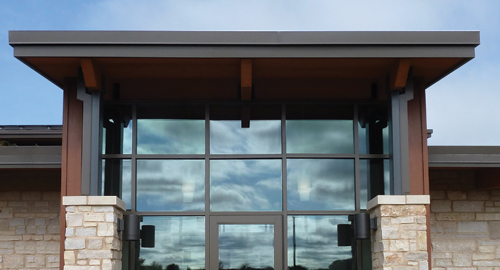 |
Incorporating a window system into a building needs to take into account the rest of the design. Here, the windows and entry are protected with a sheltering overhang that reduces the amount of wind and rain that the system is exposed to, helping to enhance its performance. Photo courtesy of Manko Window Systems, Inc. |
Each manufacturer can provide NFRC testing on established product sizes and configurations to provide information needed to determine how well a product will perform regarding building thermal performance and condensation resistance. By using the information contained on the NFRC test reports, a reliable comparison can be made between one product and another. All energy performance values represent the rating of a window as a whole system taken together and list at a minimum the following values:
U-Factor: The rate of heat loss is indicated in terms of the U-factor (U-value) of a total window assembly. U-factor ratings generally fall between 0.20 and 1.20. (The lower the U-value, the greater a window's resistance to heat flow and the better its insulating value.)
Solar Heat Gain Coefficient (SHGC): The SHGC is the fraction of incident solar radiation admitted through a window (both directly transmitted and absorbed) and the amount subsequently released inward. SHGC is expressed as a number between 0 and 1. (The lower a window's solar heat gain coefficient, the less solar heat it transmits.)
Visible Transmittance: The visible transmittance is an optical property that indicates the amount of visible light transmitted. VT is expressed as a number between 0 and 1. (The higher the VT number, the higher the amount of light that is transmitted.)
In addition to these values, manufacturers have the option of testing for and displaying values for two other significant factors:
Air Leakage (AL) is indicated by a rating expressed as the equivalent cubic feet of air passing through a square foot of window area (cfm/sq ft). Since significant heat loss and gain can occur by infiltration through cracks or joints in the window assembly it is often very appropriate to specify a maximum AL rating for a window assembly. The lower the AL rating the lower the amount of air that passes through the window assembly. While the NFRC lists this as an item to report, it should be noted that this testing protocol has not yet been fully implemented, particularly in commercial windows. AAMA ratings are currently more relevant for this characteristic.
Condensation Resistance (CR) measures the ability of a product to resist the formation of condensation on the interior surface of that product. The higher the CR rating, the better that product is at resisting condensation formation. NFRC notes that "while this rating cannot predict condensation, it can provide a credible method of comparing the potential of various products for condensation formation." CR is expressed as a number between 0 and 100.
With these standards as a basis we can look in more detail at specific window system types and how they can meet high performance criteria.
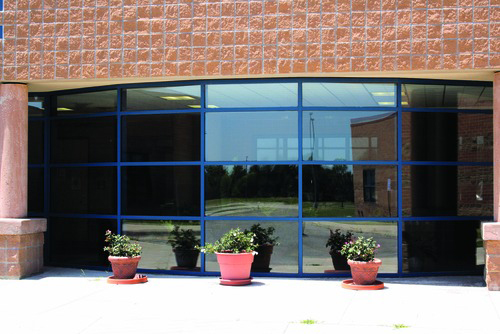 |
Single-story storefront system used in a common light commercial retail setting Photo courtesy of Manko Window Systems, Inc. |
Storefront Window Systems
Storefront systems take their name from retail settings, where they are commonly used for large, single floor height openings of glass. These systems were designed for light commercial single-story retail viewing and readily incorporate entrances for quick access to interior product displays. They are often used on interior applications such as shopping malls or schools as well as exterior light commercial applications. They typically span floor to floor or floor to head condition without passing in front of any intermediate anchorage conditions. Most storefront designs utilize small, non-obstructive, aluminum framing shapes that present "flush glass appearance" where glass seems to disappear into the framing system. Factors influencing the selection of this type of system include the following:
Storefront Structural Performance: As a light commercial system, storefront systems are typically limited to a maximum height of 12 feet due to the limited capacity of the framing and glazing system. Since the primary attachment is at the top and bottom (i.e. head and sill), the width of a properly designed system can theoretically stretch on indefinitely. The wind load resistance or Performance Grade of storefront systems generally cannot withstand more than 40 psf, so specifying anything higher class will not likely be attainable. Note that AAMA has established performance tests designed for storefront systems that are intended to simulate expected field use which are very similar to tests used for pre-glazed windows. However, there are notable differences that make a direct comparison difficult. For example, storefront test sizes are typically larger (144 in. wide by 120 in. tall) than pre-glazed windows (1/3 – 1/2 storefront test size). Further, storefront test pressures are generally limited and can be expected to be less than those available on many CW and AW pre-glazed windows. Hence testing does not support specifying storefront systems with a high-performing CW or AW class rating, rather LC class would be more appropriate.
Storefront Thermal Performance: Typically, storefront systems are not always offered with truly high-performance thermal characteristics. Nonetheless, when specifying, select the highest performing glass available that is appropriately coated and treated to suit the thermal needs of the buildings and local conditions. The local glazier and installer may or may not be able to use non-conducting insulating foam spacers between layers of insulated glass instead of metal, but specifying the best available means to minimize thermal bridging between glass layers along the glass edges is appropriate. Similarly, the thermal properties of the frame must be managed to create true thermal breaks between the interior and exterior portions of the frame based on the design of the storefront frame. Finally, due to the field installation, air infiltration rates may vary widely from site to site, not only within the storefront system, but around the exterior where it meets the adjacent building materials. Examination of the sealant around all edges is warranted and in some cases, even field testing to determine any areas of air infiltration breaches.
Storefront Water Management: Since storefront systems are designed for single-story applications of up to 12 feet tall, the integral water management of these systems is not designed to handle any more water than that. Typically storefront systems are designed to allow excess water to seep past gaskets consistent with their lower performance class and grade. This water is then collected internally by horizontal frame members and channeled into the adjacent framing members. From there, this water is intended to drain down to the sill flashing members and exit out through weep holes. Obviously the effectiveness of this type of water management system is limited by the size and frequency of the channels and the weepage available. Storefront system designs that contain a greater number of members and joints obviously also have a greater number of places where water can infiltrate through those joints. Further, if the storefront system is installed in a situation where the amount of water infiltrating the frame exceeds the capacity to drain it away, then the water can overflow into the building and cause damage there. Protecting a storefront system with a canopy or other external protection can help in this regard.
Storefront Fabrication: Storefront systems are generally fabricated locally by a glazing sub-contractor from standardized parts provided by a manufacturer. Typically, the same local fabricator is also the installer of the system and will field install the glass or infill materials. While this allows for considerable flexibility and responsiveness, it also reduces uniformity of fabrication and inherently creates more variation between installers with regard to performance. Due to this field assemblage of storefront, the warranty for the fabrication and installation is provided by the local sub-contractor and not by the manufacturer.
Storefront Strengths: Storefront systems are generally viewed as convenient for contractors with multiple local suppliers/installers able to produce a system within a relatively short lead time. The field installation with a dry gasket system means that fabrication is readily available and subsequent re-glazing or replacement is easy. In terms of cost, these systems are typically the least expensive when compared to curtain walls or pre-glazed window systems.
Storefront Limitations: Since these systems are intended for single-floor installations, they are not designed with an internal structural capacity beyond that. That means that there are very limited provisions for a supplemental structure within the frames and their Performance Grade ratings are limited accordingly. Thermally, they are not typically offered with all of the high performance characteristics that are desired, and performance becomes very dependent on the proper field installation of the system. From a design standpoint, they also offer limited customization of mullions and accessories, limited anchorage options, and limited opening configurations. Finally, the full performance of the system is typically covered by a warranty that comes from the local supplier/installer and not a national manufacturer.
Storefront Applications: Storefront systems are best suited for low-rise applications typically on the ground floor. However, they may be used on a second floor as long as the code and environmental conditions don't require higher structural and/or water management performance than is possible with these inherently limited systems. Storefront systems should never be stacked directly on top of each other and should not be used in upper stories of mid- to high-rise buildings. From a thermal performance standpoint, they are best used in situations where energy or comfort are not the first priority since they typically cannot perform as well thermally as other choices. Storefront systems are also quite appropriately used for interior applications such as shopping malls, schools, etc. where simple separation of conditioned space is sought.
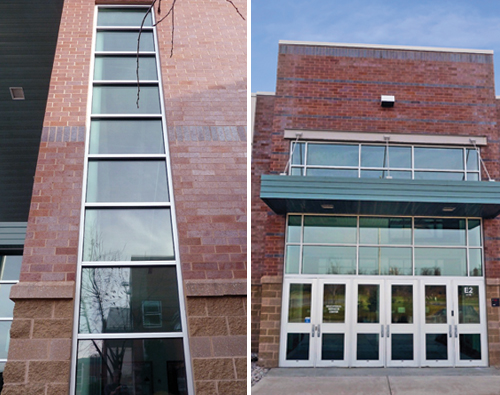 |
Improper uses of storefront glazing. On the left, multiple layers stacked on top of each other create a water management problem with a high potential for failure. On the right, a storefront system stacked on top of a door system without the benefit of structural support between the doors creates a structural performance issue. Photo courtesy of Manko Window Systems, Inc. |
Storefront Water Management: Since storefront systems are designed for single-story applications of up to 12 feet tall, the integral water management of these systems is not designed to handle any more water than that. Typically storefront systems are designed to allow excess water to seep past gaskets consistent with their lower performance class and grade. This water is then collected internally by horizontal frame members and channeled into the adjacent framing members. From there, this water is intended to drain down to the sill flashing members and exit out through weep holes. Obviously the effectiveness of this type of water management system is limited by the size and frequency of the channels and the weepage available. Storefront system designs that contain a greater number of members and joints obviously also have a greater number of places where water can infiltrate through those joints. Further, if the storefront system is installed in a situation where the amount of water infiltrating the frame exceeds the capacity to drain it away, then the water can overflow into the building and cause damage there. Protecting a storefront system with a canopy or other external protection can help in this regard.
Storefront Fabrication: Storefront systems are generally fabricated locally by a glazing sub-contractor from standardized parts provided by a manufacturer. Typically, the same local fabricator is also the installer of the system and will field install the glass or infill materials. While this allows for considerable flexibility and responsiveness, it also reduces uniformity of fabrication and inherently creates more variation between installers with regard to performance. Due to this field assemblage of storefront, the warranty for the fabrication and installation is provided by the local sub-contractor and not by the manufacturer.
Storefront Strengths: Storefront systems are generally viewed as convenient for contractors with multiple local suppliers/installers able to produce a system within a relatively short lead time. The field installation with a dry gasket system means that fabrication is readily available and subsequent re-glazing or replacement is easy. In terms of cost, these systems are typically the least expensive when compared to curtain walls or pre-glazed window systems.
Storefront Limitations: Since these systems are intended for single-floor installations, they are not designed with an internal structural capacity beyond that. That means that there are very limited provisions for a supplemental structure within the frames and their Performance Grade ratings are limited accordingly. Thermally, they are not typically offered with all of the high performance characteristics that are desired, and performance becomes very dependent on the proper field installation of the system. From a design standpoint, they also offer limited customization of mullions and accessories, limited anchorage options, and limited opening configurations. Finally, the full performance of the system is typically covered by a warranty that comes from the local supplier/installer and not a national manufacturer.
Storefront Applications: Storefront systems are best suited for low-rise applications typically on the ground floor. However, they may be used on a second floor as long as the code and environmental conditions don't require higher structural and/or water management performance than is possible with these inherently limited systems. Storefront systems should never be stacked directly on top of each other and should not be used in upper stories of mid- to high-rise buildings. From a thermal performance standpoint, they are best used in situations where energy or comfort are not the first priority since they typically cannot perform as well thermally as other choices. Storefront systems are also quite appropriately used for interior applications such as shopping malls, schools, etc. where simple separation of conditioned space is sought.
 |
Improper uses of storefront glazing. On the left, multiple layers stacked on top of each other create a water management problem with a high potential for failure. On the right, a storefront system stacked on top of a door system without the benefit of structural support between the doors creates a structural performance issue. Photo courtesy of Manko Window Systems, Inc. |
Curtain Wall Window Systems
A curtain wall system is a complete exterior envelope facade system which provides a non-structural, relatively lightweight, weather-tight covering on buildings. They impact the design appearance of the exterior of course, but it should not be forgotten that they are also notable design elements on the interior of the building as well— typically visible from floor to ceiling. In the case of small, low-rise projects, the system may be field fabricated or "stick built" and glazed using standard components similar to a storefront system. However, curtain wall components are notably different in design and performance characteristics with typically much better results compared to storefront components. For larger, multi-story projects with repetitive and large-scale surfaces, pre-fabricated and factory-glazed or "unitized" systems may be warranted to create a monolithic assembly. In either case, curtain wall systems are generally installed outside of the structural system of a building running past floor slabs and other structural elements. They are then attached via tiebacks directly to the building structure at floors, columns and beams. This installation process means that all wind loads and dead loads imposed on the system are compartmentalized and transferred directly to the building structure. Hence the curtain wall system carries only its own weight and loading while the building structure absorbs all imposed loads. Factors influencing the selection of this type of system include the following:
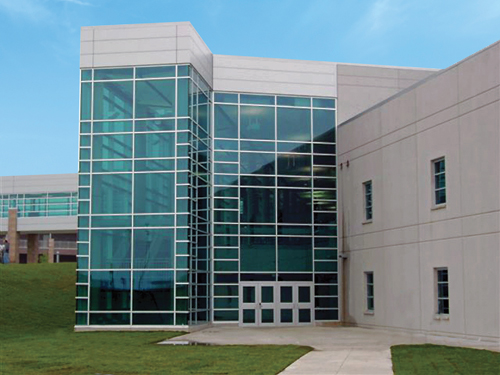 |
A proper use of curtain wall extending multiple floors and correctly incorporating doors into the façade with supports aligned Photo courtesy of Manko Window Systems, Inc. |
Curtain Wall Structural Performance: Since curtain wall systems are attached directly to the building structure, their size is virtually unlimited horizontally or vertically as long as the building is designed to carry the transferred loads. The wind load resistance or Performance Grade of curtain wall systems can be notably increased over the ratings of storefront systems. In part this is because the internal structure of the system can be increased in size or enhanced with structural pieces that are then concealed in aluminum sections. Typically curtain wall is designed to meet or exceed class CW or AW ratings and can accommodate design pressures well over 100 psf, making them ideal choices for high-rise installations subject to higher wind loads or even hurricane prone environments. However, they also perform extremely well at lower PG ratings on lower floors and in less extreme environments.
Curtain Wall Thermal Performance: Curtain wall systems typically are capable of superior thermal performance depending on the choices made for the components of the system. First, select high-performance glass that is appropriately coated and treated to suit the thermal needs of the building and the local environmental conditions. In so doing, the glazing U-factor and Solar Heat Gain Coefficient can be optimized without necessarily compromising the desired Visible Transmittance. From there, the spacer used in insulated glass layers should be upgraded to a structural tri-seal foam spacer to minimize thermal bridging between glass layers along the edges. Finally the frame members must have true, continuous, thermal breaks between the interior and exterior portions of the frame. This will not only reduce thermal bridging between the inside and outside, it will contribute to reducing the likelihood of condensation forming on the frames. In cases where air infiltration is a particular concern, the curtain wall system will likely maintain a higher degree of consistent quality control with tighter resistance to air infiltration, particularly if they are factory glazed.
Curtain Wall Water Management: Since curtain wall systems can extend for many stories, a very different water management system is employed compared to storefront systems. Rather than using horizontal and vertical members to channel water internally to a single sill flashing condition, curtain walls employ weep holes at every horizontal member to discharge any excess water that may enter the system. In most designs, the tighter sealing and fabrication reduce the amount that may enter in the first place, but this incremental weepage approach means that water does not have the opportunity to collect anywhere and cause potential damage to the building.
Curtain Wall Fabrication: As already noted, curtain wall systems can be fabricated either on site for small low-rise projects or in the factory for projects of any size or type. The choice between these two will have other impacts on the total fabrication and installation process. Site-fabricated systems can accommodate on-site variations, modifications and more complex shapes while factory-fabricated systems are pre-engineered making them better suited for larger and simpler monolithic installations. Of course, site-fabricated systems require more on-site time for installation and have correspondingly higher site labor costs than factory-produced units. In part this is because site-fabricated systems are intended to be installed from the exterior of the building (another reason to limit them to low-rise installations) while unitized systems are installed from the interior of the building. Naturally any pre-fabricated curtain walls will require time to be manufactured and shipped meaning that lead times need to be scheduled. Finally, the choice of system type has an impact on the type of joint control and movement capabilities of the components. Site-fabricated systems are commonly very limited in this regard while factory-produced systems typically come with interlocking frames that accommodate normal building movement.
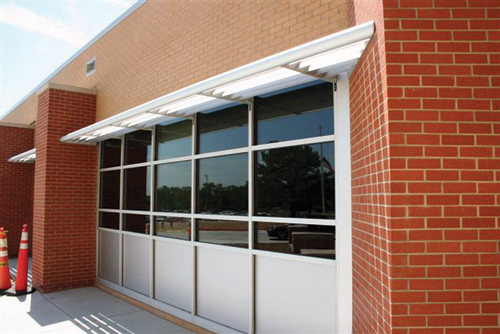 |
An external solar control device integrated into the curtain wall system allows for the proper structural transfer and coordination of components, particularly if they are made by the same manufacturer. Photo courtesy of Manko Window Systems, Inc. |
Curtain Wall Strengths: Curtain wall systems perform in a superior manner over storefront systems. This is true in terms of available wind performance, water management and thermal performance. From a general standpoint, they also exhibit a considerable number of design strengths. They are easy to customize, are available with a variety of interior and exterior aesthetic appearances, and allow a virtually unlimited range of installation locations, configurations and opportunities. The typically single-source product design and fabrication means that specific decisions can be made early related to anchoring options, accommodation of specified glazing thickness, and other details. Further, many curtain wall manufacturers offer accessory items such as sun shades or light shelves to enhance daylighting approaches for the overall building. The significance of acquiring these accessories from the same source should not be overlooked since these components add notable stress and strain not only to the curtain wall system, but to the building structure as well. Coordination and integration into the overall curtain wall design will help avoid potential problems later. Finally, from a building operation standpoint, it should be noted that many curtain wall systems use dry gasket systems which allows for simplified re-glazing should it be needed for any reason in the future.
Curtain Wall Limitations: For factory-made curtain walls, proper scheduling and planning are required to allow for the production and delivery of the system. Certain standardized systems are readily available, but with greater customization often comes greater lead times that need to be allowed for. Beyond the schedule, the cost of curtain wall systems is often cited as higher than other systems. Field fabricated curtain wall systems may cost about 40-60% more than storefront systems while factory glazed and shipped systems may, in some cases, be up to twice the cost of storefront systems. However, none of this is surprising considering the higher quality and higher performance that is usually included in curtain walls. Of course, cost will predictably vary based on the Performance Class and Performance Grade specified. In some cases it may be worth doing a life cycle analysis on the system compared to less expensive systems to identify potentially higher long-term costs for maintenance, repairs and replacement, not to mention higher potential building energy costs compared to poorer performing systems.
Curtain Wall Applications: Site fabricated curtain wall systems are best suited for smaller, low-rise projects that need high performance but seek the uniform appearance of continuous glazing systems. They can also be used on first-floor locations instead of storefront systems to achieve the desired performance and help control costs as well. Since a local fabricator/ installer can provide the system on site, custom variations and complex shapes are more readily accommodated with this type of system. By contrast, factory-made unitized curtain wall systems are best suited for low- to high-rise buildings that require superior performance. They are also well suited to situations where customization of the system itself is desired while the general shape of the system is kept simpler and more monolithic.
Pre-glazed Window Systems
Pre-glazed windows as described here are simply manufactured products that are designed to be inserted into "punched" openings in building walls. They can be a fixed glazing unit which is sealed shut or can be an operating unit offering open and closed positions for fresh air and ventilation. Pre-glazed windows can be used as single installations in a wall or if used in combinations, they can be ganged together to create larger openings sometimes called "strip windows, ribbon windows, or window walls." Window units are typically set into the wall openings with the perimeter head, jambs and sills anchored to adjoining wall section materials.
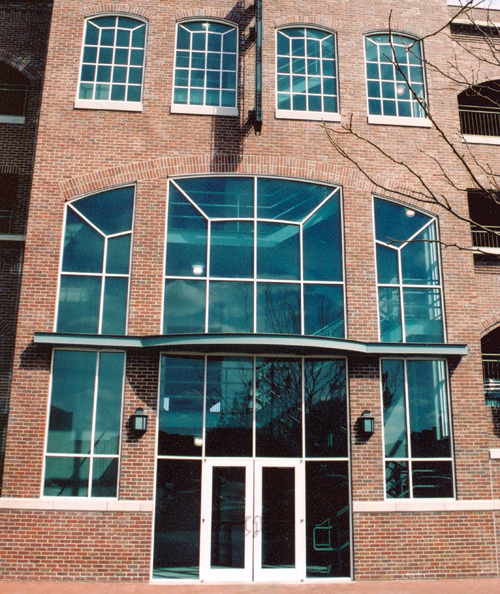 |
Selecting the appropriate glazing system is important for good performance. In this building, a curtain wall system with integrated doorways is used above and below the canopy in the large openings. In the smaller punched openings above, pre-glazed windows have been designed and installed successfully. Photo courtesy of Manko Window Systems, Inc. |
< page 8 >
Common among them, are the characteristic of being factory made with the associated levels of consistent quality control and performance levels that come from a manufacturing environment. Factors influencing the selection of this type of system include the following:
Window Structural Performance: Pre-glazed windows are anchored into openings in the exterior wall construction and subsequently transfer their loads back to the building structure. Their size, nonetheless, is limited by the manufacturing process, the restraints of glass size, the wind loads that can be carried by the window unit itself, and in some cases by the performance of hardware used on the window. If window units are ganged together, they are limited by the ability of the intermediate building structure between or around the windows to carry the transferred loads. The wind load resistance or Performance Grade of pre-glazed windows generally falls between the levels of storefront and curtain wall systems. Class R products are appropriate for low-rise residential buildings, class LC for low-rise commercial needs, and class CW or AW products can achieve PG ratings of up to 100 psf or more, making them quite suitable for a wide range of installations.
Window Thermal Performance: Also similar to curtain wall systems, pre-glazed windows are also capable of superior thermal performance. High-performance glass can be specified based on availability from a particular window manufacturer to achieve desired U-factors and SHGC values. While window units are commonly made with clear glass with high Visible Transmittance, it is also possible to specify other types of glass and coatings in individual windows. In regards to the spacer in insulated glass layers, it is reasonable to require structural tri-seal foam for manufactured windows. If the window frame is made from aluminum, then the frame members are likely available with proper thermal breaks and should be specified. Ultimately, the unit should be NFRC certified and the product should demonstrate the tested performance to show compliance with the specifications.
Window Water Management: Pre-glazed window units are inherently smaller than storefront or curtain wall, which means the surface area to collect water is less. Nonetheless, horizontal members can be a source of unwanted water seepage particularly in operable units. Hence, should any water seep into the window frame, a sub-sill is typically incorporated into the window unit to allow water to collect away from the window or the building and then weep out of the bottom.
Window Fabrication: By our definition, pre-glazed windows are fully factory fabricated and glazed then shipped to the site for installation. They may or may not require as much lead time as curtain walls particularly if standardized sizes are selected that are readily available. Further, they have the benefits of factory fabrication in that they require less on-site installation time and have lower site labor costs, particularly if the installation takes place from the interior rather than the exterior of the building. The installation details will vary based on manufacturer and wall construction but window units can typically be installed in most wall types and sealed appropriately around their perimeter.
Window Strengths: Pre-glazed windows generally perform structurally quite well on a level approaching curtain wall performance levels. Thermally, windows can achieve true high performance that can be customized and pre-engineered. From a general design standpoint, they also offer some other strengths. Manufacturers offer a wide range of both operable and non-operable selections in terms of size, type, style and performance ratings. That also means that a variety of appearance features can be selected and specified which can contribute to the overall design appearance of the building. If natural ventilation or emergency egress is a building design requirement or desire, then this window system offers the most choice in those regards. Further, different depths of walls or different locations of windows can generally be accommodated through coordinated detailing and anchoring options. Finally, from a cost perspective, pre-glazed windows offer the high-performance potential associated with pre-manufactured products but at a cost notably below the cost of curtain walls.
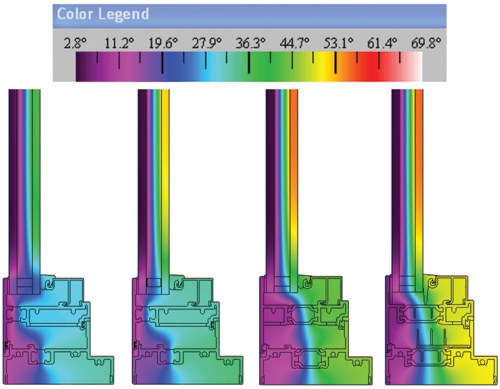 |
The evolution of thermal improvements in pre-glazed windows is depicted by the improvements in frame, glazing and spacer design that led to better energy performance, warmer interior temperatures and greater resistance to condensation. Photo courtesy of Manko Window Systems, Inc. |
Window Limitations: As with other manufactured products, appropriate lead times need to be scheduled, although for window units that time is commonly short. Budgeting for window systems will be dependent on making decisions in design and specifications early and selecting properly from the wide variety of choices to maintain accurate cost estimates. Heavy customization of some pre-glazed window systems will either increase the cost notably or will not be fully available. Alternating between fixed and operable units will create differences in the mullion profiles and appearance of the windows in many cases which will need to be resolved as a design issue. In terms of operations and maintenance, re-glazing and repairing can be hampered by removing and re-installing a wet glazing compound as is commonly used.
Window Applications: Pre-glazed window systems can be specified and designed for buildings and locations of virtually any type or location. They are particularly appropriate in wall systems that are conducive to punched openings and that require a smaller ratio of wall area to window area. This may be dictated by the requirements of the building structure or by the thermal performance of the building where highly insulated wall areas are needed more than glazed areas. Window wall designs that use multiple units will have all of the same opportunities for successful solutions as single window installations as long as the rest of the building is appropriately designed to accommodate them. This can be true regardless of the floor level where they are installed provided they are designed and specified to the appropriate performance class and grade.
Conclusion
Selecting the best type of glazing system for a particular building requires that the design professional involved has a solid understanding of the fundamental choices available within the categories of storefront, curtain wall and pre-glazed window systems. To go further and achieve true high performance, it is imperative that the appropriate system and component parts are understood, designed, specified and installed properly. Selecting a system that does not match the building and location criteria can lead to the unwanted consequences of increased cost, poor performance, or damage to the building. Proper design and selection of high-performance glazing systems will contribute to the long-term integrity and trouble-free operation of the building for many years following their installation.
 |
| MANKO Window Systems, Inc. provides contract glazing companies with a reliable, efficient source of projected and fixed commercial windows. They currently produce 29 types of commercial window systems, 18 types of entrance doors, 6 storefront systems and 6 curtain wall systems. www.mankowindows.com |
